Embedded Picture Mnemonic bookmarks and desk mats
0 RepliesHelp beginners link speech sounds and letters/spellings with our new, printable embedded picture mnemonic bookmarks and desk mats.
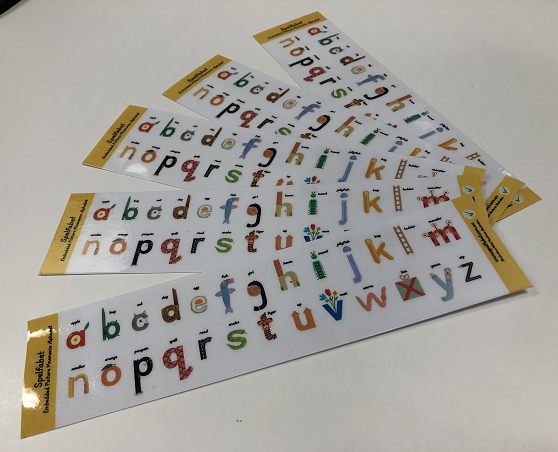
The bookmarks are single-sided, with one mnemonic for each letter of the alphabet. Five print to an A4 page. Save, print, laminate and cut up for distribution to literacy beginners. If/when some are lost/damaged, just print extras.
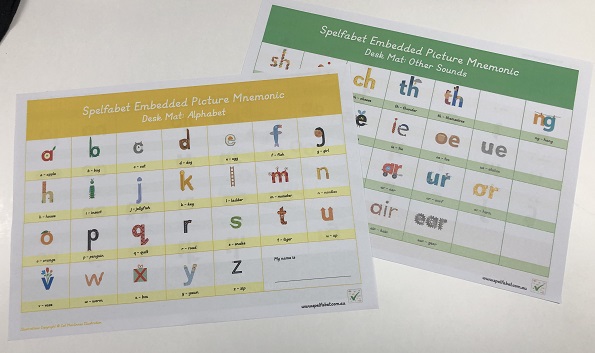
The desk mats have the alphabet on one side, and a mnemonic for each of the other sounds on the flip side. Print just the first side for beginners, or both sides to show learners that there are more sounds than letters, so many are written with letter combinations.
There are three versions, to suit different accents and preferences, all with the new y/yawn mnemonic:
- A version for most Australian, UK, NZ and other speakers of non-rhotic Englishes, with e/egg, k/key, o/orange, u/up, ur/surf, air/hair and ear/gears.
- A more Aussie version as above, but with k/kangaroo and u/undies (yes! back by popular demand).
- A version for US, Canadian and other speakers of rhotic accents, with e/echo, k/key, o/octopus, u/up, wh/whale, ur/burn, and aw/claw, but no air/hair or ear/gears.
Prices assume each purchaser will print enough for their class/caseload.
We hope you like them!
“Can I halp you?” The Salary-Celery merger
0 RepliesIf you’re in south-eastern Australia or New Zealand, you’ve probably noticed kids pronouncing words with /e/ (as in ‘egg’) more like /a/ (as in ‘at’) before the sound /l/.
They say things like ‘Can I halp you?’, ‘I falt a bit sick’ and ‘I can do it mysalf’. They pronounce ‘salary’ and ‘celery’ as homophones, hence the name linguists have given this vowel shift: the Salary-Celery merger.
The ‘a’ before /l/ in ‘asphalt’ was being pronounced /e/ when I was scraping my knees on it at school, but ‘a’ pronounced /e/ mainly occurs before /n/, as in ‘any’, ‘many’, ‘secondary’ and ‘dromedary’.
Several other vowels have also morphed a bit before /l/, consider:
- all, ball, call, fall, gall, hall, mall, also, almost, always etc (but not ‘shall’, ‘ally’, ‘alley’, ‘ballad’, ‘gallop’, ‘pallet’, ‘tally’ or ‘alas’).
- walk, talk, chalk, stalk, and baulk (US balk) and caulk (US calk).
- half/halve, calf/calve, behalf (but not ‘salve’ or ‘valve’).
- salt, halt, malt, gestalt, alter, exalt, Walter (but not ‘shalt’).
- fault, vault, cauldron, assault, cauliflower, hydraulic, somersault (but not ‘haul’ or ‘maul’).
The sound /l/ has a vowel-like quality and tends to ‘colour’ the preceding vowel. This is useful for teachers to know, so they can give any confused kids plenty of practice spelling affected words (there’s lots of opportunities to practice writing ‘short vowels’ in a range of phonetic contexts, including before /l/, in Spelfabet Workbook 1)
When kids insist that they hear an /a/ (as in ‘cat’) in ‘halp’, I ask them to say the word in their ‘spelling voice’ (as it’s written), with /e/ (as in ‘red’). Good spellers often say that they pronounce odd spellings a bit weirdly when writing them (Wed-nes-day, bus-i-ness), as a kind of mnemonic. Spelling pronunciations sometimes crop up in comedy too, for example the kniggits in Monty Python and the Holy Grail.
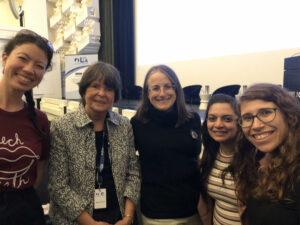
US reading/spelling guru Professor Linnea Ehri was recently here in Melbourne courtesy of Learning Difficulties Australia (the selfie at right proves we met her), and talked about this strategy, which she calls the “Spelling Pronunciation Strategy”. She says that in Connectionist theory, to put a word’s spelling into long-term memory, the letters must be connected to ‘phoneme mates’ in the pronunciations of the word.
To use the Spelling Pronunciation Strategy (AKA “Spelling Voice” in the program Sounds-Write) you separate and say each syllable with stress, and pronounce all the letters. Prof Ehri’s examples were “ex cell ent ”, “lis ten”, “choc o late”, and “Feb ru ary”. She cited two studies (Drake & Ehri, 1984 and Ocal & Ehri, 2017) showing that assigning spelling pronunciations enhanced memory for spellings, in 4th graders and college students.
So in summary, it’s not just harmless to say words in a slightly funny way to halp, sorry, help yourself remember their spellings. It’s officially evidence-based.
Why do we say the past tense suffix -ed three ways?
13 RepliesYoung children learning to sound out words often write ‘jumped’ as ‘jumpt’ or ‘jumt’. They write the verb ‘filmed’ as ‘filmd’ and ‘landed’ as ‘landud’ or ‘landid’, depending on their accent.
They’re writing what they say/hear, which is great, but English has a special spelling for the regular past tense suffix: -ed. This spelling shows readers that, for example, the intended meaning is ‘packed’ (the bag) not ‘pact’ (between two countries).
But why do we pronounce this suffix three different ways? Why do we also have three pronunciations for regular plural and third person present inflectional suffixes, as in ‘kicks‘ (sounds like /s/), bends‘ (sounds like ‘z’) and ‘wishes‘? (sounds like /es/ or /uz/, depending on your accent). And what’s an inflectional suffix, anyway?
Here’s my third Fun Spelling Facts for Grownups video, in which I try to relate the visible part of our writing system (orthography) to the sounds (phonology) and meanings (morphology) in our spoken language. It’s 7.5 minutes long (yes, I talk too much), but the past tense -ed part is first. Hope it’s useful.
Spelling for grown-ups 1: /s/ spelt C and /j/ spelt G
17 Replies
Hooray for recent media reports of a greater emphasis on phonics in the draft Australian National Curriculum.
I’m not a fan of some of the other proposed changes, but more and better teaching of phonics and word-building should prevent a great deal of reading/writing failure, especially among disadvantaged students.
Unfortunately, adults – including many teachers – tell me that they were never taught much about how our spelling system works. This makes it hard for them to teach it well.
I’ve therefore started making a series of what I hope are helpful 5-minute videos for adults about major spelling patterns. Here’s the first one:
Once teachers understand our spelling system, and aren’t hamstrung by unhelpful curriculum requirements, they’ll drop unhelpful spelling-teaching approaches like rote-memorisation of high frequency wordlists, silently writing the same word in many different colours, and other activities not focussed on linking a word’s sounds, spellings and meanings.
Teachers will be able to systematically, explicitly and authoritatively teach how speech sounds are represented by spellings, and how many long words are built from meaningful parts with special spellings. This will help many more children learn to spell and read successfully.
Affordable basic phonics kit
6 Replies
Thanks to the pandemic, many children seem to have done year or more of disrupted schooling without having learnt to read or spell much. A new batch of Australian five-year-olds start school soon, where many will (happily) be taught the systematic, explicit phonics that’s helpful for all, harmful for none and crucial for some*, but many won’t.
The download-and-print Spelfabet Level 1 kit aims to equip you to help beginners and strugglers of any age learn to read and spell one-syllable words with up to seven sounds. The kit follows this teaching sequence (the same as the Sounds-Write program):

The kit contents are a workbook, quizzes, moveable alphabet, word-building sequences, playing cards, reading journal and phonics picture book. The only difference between the parent/aide kit and the teacher/clinician kit is how many copies of the workbook you may print (5 or 30 copies).
All the items in this kit are available separately from the Spelfabet website, except the simplified Moveable Alphabet, which contains only the spellings needed for Level 1. However, it’s cheaper to get the kit than each item separately ($55 including GST for the parent/aide version and $65 for the teacher/clinician one).
Decodable books for reading practice which follow the same teaching sequence include the Units 1-10 Sounds Write books including free e-books, the Units 1-10 Dandelion and Moon Dogs books from Phonic Books, and the printable Drop In Series Levels 1 and 2.
If this kit is too basic for your learner(s), more difficult kits will be available soon.
* See article by Catherine Snow and Connie Juel (2005) at https://psycnet.apa.org/record/2005-06969-026
New Spelfabet workbooks and EOFY discount
24 Replies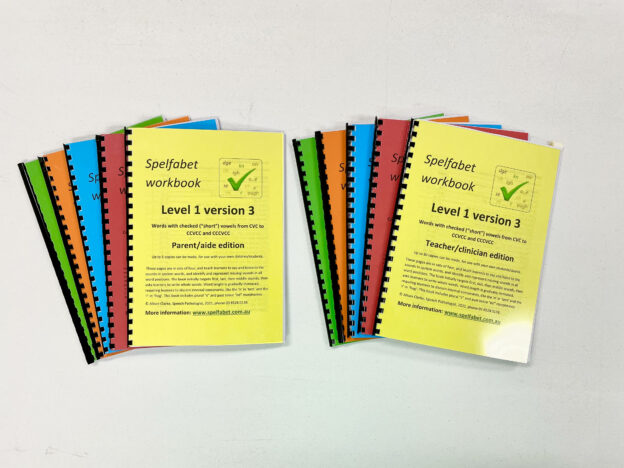
I’ve finally finished five new download-and-print Spelfabet workbooks. These version 3 books better align with the Sounds-Write program and the Phonic Books myself and my colleagues are now often using, and with the Drop In Series books for older learners.
For a 20% discount on these and anything else in the Spelfabet shop, type the coupon code “EOFY 2021” at the checkout.
Many of our clients have memory, attention, language or other difficulties as well as learning difficulties, and struggle to make the transition from Sounds-Write’s Initial Code to the Extended Code, which requires them to learn several spellings of a new vowel sound at once.
We only see our clients weekly or fortnightly, so need lots of activities that are easy for parents to supervise at home. I thus wanted new workbooks to teach vowel spellings more gradually, with earlier, explicit teaching about morphemes and work on polysyllabic words, and reviewing prior learning in lots of sentence-writing with punctuation (having read The Writing Revolution).
I’ll be talking about meeting the needs of clients like these at the free online Sounds-Write 1:1 Symposium on May 23-28. The lineup is amazing, it’s hard to know where to start, don’t miss it!
I’ve made videos about each new workbook, in which I hope you enjoy my fire-engine red fingernails (covering ugly nail bruise from dropping a chookhouse paving stone on my finger, yeow). There are also detailed descriptions of each book in the website shop, but essentially their contents are:
Level 1: Words with checked (‘short’) vowels from CVC to CCVCC and CCCVCC (C=consonant, V=Vowel)
Level 2: Consonant digraphs, basic suffixes, and up to three-syllable words with varied stress
Level 3: “Long/short” vowel contrasts, “soft” c and g, extra suffixes and some prefixes
Level 4: Seven extra vowel sounds, four extra vowel spellings, and more practice of patterns introduced in earlier books.
Level 5: 14 extra vowel spellings and more practice of previous patterns.
Like the previous workbooks, Version 3 has a parent/aide edition and a slightly more expensive teacher/clinician edition, the only difference being that you can print more copies of the teacher/clinician file. File pictures are in colour, but you don’t have to colour print them. Most of the pictures in the workbooks are PCS, a trademark of Tobii-Dynavox LLC, all rights reserved, used with permission.
The old Version 2 workbooks and kits are still in my website shop in the “old versions” folder, if you still want one, or haven’t finished downloading ones you’ve bought. Sorry that I’ve only been able to finish half the workbooks for Version 3, I’m working on more now, but life is busy!
Hope you and yours are all staying virus-free (I’ve had my first vaccine), and I’d love to hear your thoughts on the new workbooks.
New Embedded Picture Mnemonics now available
11 Replies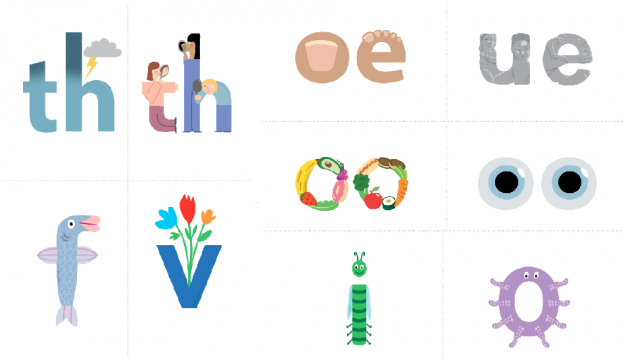
Despite a universe determined to throw spanners in my works, I’ve finally put artist Cat MacInnes’ new, improved version 2 Embedded Picture Mnemonics into the Spelfabet website shop. If you already bought version 1, you can now upgrade for free.
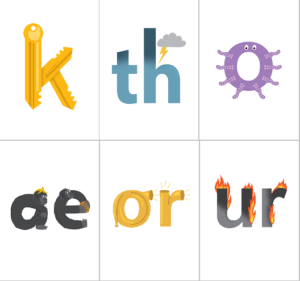 Research has shown embedded picture mnemonics help children learn the relationships between speech sounds and letters.
Research has shown embedded picture mnemonics help children learn the relationships between speech sounds and letters.
There are now two versions of the Spelfabet Embedded Picture Mnemonics: one for speakers of Australian/British (non-rhotic) English, and one for speakers of American (rhotic) English. If you speak another version of English, download both files and mix and match to suit your accent.
Each set contains a mnemonic for each sound (phoneme) plus one for each of the three letters that represent the same sound as c (k, q, x). The pictures are now more relevant outside Australia, with k as in ‘key’ not ‘kangaroo’, ur as in ‘burn’ not ‘surf’ and u as in ‘up’ not ‘undies’ (I’m a little sad about the undies, so if you are too, just keep using the original mnemonic).
The sets now contain ‘o’ as in ‘octopus’, ‘ue’ as in ‘statue’, ‘or’ as in ‘horn’, ‘th’ as in ‘thunder’ and ‘themselves’, and ‘f’ as in ‘fish’ (no adjacent consonant). There are new ‘aw’ as in ‘claw’ and ‘wh’ as in ‘whale’ mnemonics in the US set. The relationship between ‘short’ and ‘long’ vowels is now clearer, as the ‘long’ vowels have a consistent format (ae, ee, ie, oe, ue).
Both the Aust/UK and US A4 poster size files can be found here. The pictures on them are now bigger, with less white space around them.
Both the Aust/UK and US A4 flashcard size files (four to a page) are here. Consonants are in portrait format and the vowels are in landscape format, which I hope helps children understand the difference between vowel and consonant sounds.
You can make and change words with these embedded picture mnemonics, using the flashcard size with individuals and small groups, like this:
Use the poster size mnemonics if doing this with a whole class, asking a child to hold each mnemonic you’ve taught and another child to rearrange them, while the rest of the class writes down the words thus created.
You can also use the mnemonics to build Sound Walls with your class, adding sounds and/or spellings as they are taught in your phonics teaching sequence, and refreshing the wordlists as new vocabulary is learnt, so that you might end up with mnemonics that look like this:

Teachers, therapists and others have already thought of lots of other great ways to use these mnemonics – too many to list here.
Thanks for the feedback and questions about version 1, which made me think about how to improve them. I hope you like Version 2, and thanks to the always-creative Cat MacInnes for her artistic talent, patience and hard work.
Steps for upgrading a previously-purchased file:
1. Go to the Spelfabet website and click on My Account.
2. Type in the email address you used for your original purchase, and the password you created. If you can’t remember your password, just reset it.
3. Go to the downloads area, click on the file(s) you want, and save it/them to your computer before printing. Ordinarily you get three chances to download any file from the online shop, in case of computer crashes or power outages, but I’ve increased this to four for these files in case some previous purchasers have used up their first three.
Any feedback or problems, email me on info@spelfabet.com.au.



